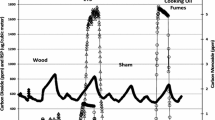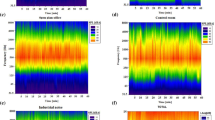Summary
Nine healthy male volunteers were exposed to m-xylene for 3 h in the morning and 40 min in the afternoon with a 40-min break in between. The atmospheric m-xylene concentrations were either stable at 8.2 μmol/l (200 ppm) or they fluctuated (5.2–16.4 μmol/1; 135–400 ppm) with peaks of 16.4 μmol/1 and duration of 20 min at the beginning of each exposure session. The subjects were either sedentary or exercised at 100 W for 10 min at the beginning of each session during both exposure types. The two control days, with and without exercise, were similar to the exposure days but without exposure. Evoked potentials were recorded in the morning before the exposure and immediately after the morning and afternoon sessions. Visual evoked potentials were studied to a pattern reversal stimulus (pattern VEP) and to a light flash (flash VEP). For pattern VEPs the latencies of P50, N70, P100, N135 and P170 as well as the peak-to-peak amplitude of N70 to P100 were measured. For flash VEPs the latencies of P50, N70, P100, N150 and P200 as well as the peak-to-peak amplitude of P100 to N150 were measured. Short-latency auditory evoked potentials arising in the brainstem (BAEP) were recorded for a click stimulus. The peaks 1, II, III, IV and V were identified from the grand averages. The effect of various exposure paradigms was evaluated by comparing the individual changes on an exposure day to those during the control days. The latency N135 of the pattern VEP decreased in exposure at 400 ppm with exercise, and the latency P210 in the flash VEP decreased both at the stable and fluctuating exposure with exercise. The results might suggest some activation of the arousal level of the subjects after the most intensive exposure situations.
Similar content being viewed by others
References
Allison T, Matsumiya Y, Goff GD, Goff WR (1977) The scalp topography of human visual evoked potentials. Electroencephalogr Clin Neurophysiol 42:185–197
Cooper R, Newton P, Reed M (1985) Neurophysiological signs of brain damage due to glue sniffing. Electroencephalogr Clin Neurophysiol 60:23–26
Despland PA, Regli F (1985) Apport des potentiel évoqués précoces auditifs et somesthésiques dans le coma. Rev Méd Suisse Rom 105:323–329
Elofsson S-A, Gamberale F, Hindmarsh T, Iregren A, Isaksson A, Johnsson I, Knave B, Lydahl E, Mindus P, Persson H, Philipson B, Steby M, Struwe G, Söderman E, Wennberg A, Widen L (1980) Exposure to organic solvents: a crosssectional epidemiological investigation on occupationally exposed car and industrial spray painters with special reference to the nervous system. Scand J Work Environ Health 6:239–273
Genkina OA (1984) Effect of alcohol and evoked electrical activity in healthy man. Hum Physiol 10:189–192
Halliday AM (1982) Evoked potentials in clinical testing. Churchill Livingstone, Bath
Kalant H (1978) Alcohol and electrophysiology of the central nervous system. In: Olive G (ed) Advances in pharmacology and therapeutics, vol. 8. Drug-action modifications comparative pharmacology. Pergamon Press, Oxford, pp 199–209
Meienberg O, Kutale L, Smolenski C, Ludin HP (1979) Pattern reversal evoked cortical responses in normals. J Neurol 222 81–93
Obitz FW, Rhodes LE, Creel D (1977) Effect of alcohol and monetary reward on visually evoked potentials and reaction time. J Stud Alcohol 38:2057–2064
Raitta Ch, Karhunen U, Seppäläinen AM, Naukkarinen M (1979) Changes in the electroretinogram and visual evoked potentials during general anaesthesia. Graefe's Arch Clin Exp Ophthalmol 211:139–144
Riihimäki V, Pfäffli P (1978) Percutaneuous absorption of solvent vapours in man. Scand J Work Environ Health 4:73–85
Seppäläinen AM, Raitta Ch, Huuskonen MS (1979) n-Hexaneinduced changes in visual evoked potentials and electroretinograms of industrial workers. Electroencephalogr Clin Neurophysiol 47:492–498
Seppäläinen AM, Savolainen K, Kovala T (1981) Changes induced by xylene and alcohol in human evoked potentials. Electroencephalogr Clin Neurophysiol 1981; 51:148–155
Stewart RD, Fisher TN, Hosko MJ, Peterson JE, Baretta ED, Dodd HC (1972) Experimental human exposure to methylene chloride. Arch Environ Health 25:342–348
Stewart RD, Hake CL, Peterson JE, Forster HV, Newton PE, Soto RJ, Lebrun AJ (1974) Development of biological standards for trichlorethylene. In: Xintaras C, Johnson BL, IDO de Groot (eds) Behavioral toxicology. Early detection of occupational hazards. HEW Publishers, Washington, pp 81–91
Winneke G, Fodor GG, Schlipkoter HW (1978) Carbon monoxide, tricholorethylene and alcohol: reliability and validity of neurobehavioral effects. In: Otto (ed) Multidisciplinary perspectives in event-related brain potential research, EPA-600/9-77-043. DC: US Government, Printing Office, Washington, pp 463–469
Zilm DH (1981) Ethanol-induced spontaneous and evoked EEG, heart rate, and respiration rate changes in man. Clin Toxicol 18:549–563
Author information
Authors and Affiliations
Rights and permissions
About this article
Cite this article
Seppäläinen, A.M., Laine, A., Salmi, T. et al. Changes induced by short-term xylene exposure in human evoked potentials. Int. Arch Occup Environ Heath 61, 443–449 (1989). https://doi.org/10.1007/BF00386477
Received:
Accepted:
Issue Date:
DOI: https://doi.org/10.1007/BF00386477




